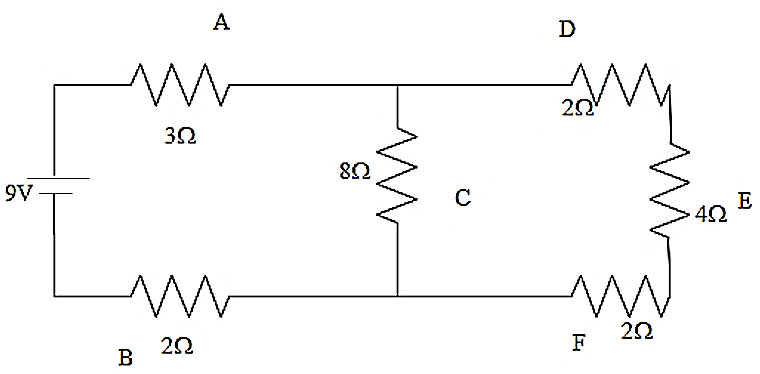Question
Question: In the electrical circuit as mentioned in given diagram, the current through the \(4\Omega \) resist...
In the electrical circuit as mentioned in given diagram, the current through the 4Ω resistor will be given as,

A.1AB.0.5AC.0.25AD.0.1A
Solution
Analyse the circuit well. The equivalent resistance is to be found first. According to ohm’s law, the potential of the circuit will be the product of the current produced and the resistance of the circuit. Using this relation find the overall current in the circuit. Then find the division of this current in each branch of the circuit. This will help you in answering this question.
Complete answer:
As we look into the diagram we can see that the resistance D, E, F are connected in series. Therefore the total resistance of these three resistances will be given as,
R1=2+4+2=8Ω
Now this effective resistance will be in parallel connection with the resistance C. This can be written as,
R21=81+81=41R2=4Ω
Now the circuit will become like this.

The three resistors in the circuit now are in series connection with each other. Therefore their effective resistance will be the sum of each of the resistance values.
That is we can write that,
Req=4+3+2=9Ω
Therefore the effective resistance of the circuit has been obtained.
According to Ohm's law, the potential of the circuit will be the product of the current produced and the resistance of the circuit. Therefore we can use it here also. The equation can be shown as,
V=IR
The potential used in this circuit has been given as,
V=9V
Let us substitute the values in it,
9=I×9⇒I=1A
The value of current in the resistor C will be
IC=1A
This current will be divided equally in both the branches as they are connected in parallel. Therefore each branch will be having a total current of,
IDEF=0.5A
As the resistors D, E, F are in series the current will be the same in all the resistors. Therefore the current in 4Ω resistor will be 0.5A.
The answer has been given as option B.
Note:
When the resistors are in series connection, then their equivalent resistance will be the sum of the individual resistance. When the resistors are connected in parallel, the reciprocal of the effective resistance of the circuit will be the sum of the reciprocal of each of the resistances.
